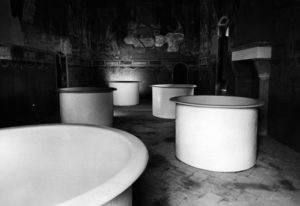For me space is a living thing. Just as I cannot conceive of bending the will of another human being to my own, so I cannot force space to conform to an image of mine. Space is governed by the same laws as matter, the universe, and we ourselves. Volume and perspective are both still external to me (although they reflect my point of view) and do not allow me to live space within space, in its every moment. I measure myself, and space, in instants rather than in millimeters.
L’immagine dello spazio (The Image of Space) in my Foligno work was not so much described as felt – for it passed directly from action to the mind without lingering on figuration.
I was given a room: by a normal exhibition convention, the entire space enclosed within its walls belonged to me, and I was asked for an image of the space rather than for an environmental work.
Architecture considers and shapes space in terms of interiors and exteriors. In order to obtain an exterior, I built smaller rooms which themselves had an interior. These occupied a variety of spaces, creating exteriors and interiors which to the visitor’s eye corresponded to a number of different moments. Before entering my room, the visitor expected to find himself directly before the “fact” of the exhibition: once inside, he found that he was still “outside”, for the room was exactly as before he entered it. So he felt somehow unsatisfied (i.e. there was a decanting of pre-figuration). He was still outside, but could sense the presence of other rooms, and was drawn to enter them. As he leaned over the first of the wells, he was struck by the sudden effervescence of perceptions: an instantaneous experience -his own image, light, and space all unified, parts of the same destiny.

Michelangelo Pistoletto, Cinque pozzi, 1966.
Photo: Tonino Romagnoli.
Immediately he felt that this perception was determined by language (i.e. rationalization) and with this vision he moved on to the second of the wells. Looking down into it, he was plunged into another moment, another place. The slight difference in internal coloring (visible on the outside rim, too) served merely to give the immediate information that this moment was different. And at this point the visitor’s perception was modified compared to the first impression, for it had already been influenced by his reason.
The space outside the wells decanted the first impressions and increased the degree of rationalization each time the visitor moved through it. In the end, all the exteriors were still visible, all the places and all the moments were still there – but they had now been lived through. Of the original perception of the image, only the memory remained: one was outside before leaving (decantation of the entire experience).
The cycle which was completed within the room can be described as follows: prefiguration – perception – rationalization – memory – detachment. Whatever reaction the visitor had (even if it differed from the one I have described) was an experience of several places and several moments condensed in the space of the room. The succession of instants, corresponding to sensations (even if not all were controlled) was equivalent to a cycle that in life is normally dispersed in times and places that are considerably more difficult to determine. I considered the size and image of this environment in terms of the duration of the cycle it was able to contain. If a longer time could be contained in the experience of this same space, then I fostered an acceleration of experience in an acceleration of time. In this way the entire environment could give me a new vision originating beyond my own language: namely, is the perception that time and space have the same dimension as the experience which the acceleration of experience places within the dimension of time.

